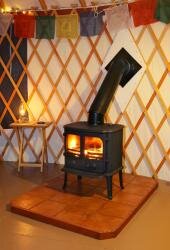Hello,
First time poster here. For reference, I'm familiar with recommended clearances between stove pipe and combustibles for which I abide by in my home. However, my family broke those rules in their sheep camps for 30+ yrs, I have recently broken the rules in my yurt and wood fired hot tub...and my friend has broken them for 20 yrs in his yurts. All without a single fire. However, that doesn't make me sleep better at night...particularly being that I believe my stove produces more BTUs than the aforementioned. I'm looking for a piece of mind.
Here's what I'm talking about: Single wall stove pipe running right through the ceiling/roof, all the way to the cap...the pipe a mere few inches to combustible materials where it goes through the roof (metal flashing). In my friends case, he is within 2" of combustibles! My personal closest is 4". I would like to improve on this.
All of these examples were/are in non-conventional back-country shelters meant for occasional use.
For simplicity, ease, and cost, what I'm thinking about is running DuraVent double wall stove pipe from stove, through my yurt roof, and to the chimney cap. I have not seen this pipe in person...and I know this isn't its intended application...so I don't know how well this will work, or what considerations I will need to take in to account.
Thoughts? Ideas?
First time poster here. For reference, I'm familiar with recommended clearances between stove pipe and combustibles for which I abide by in my home. However, my family broke those rules in their sheep camps for 30+ yrs, I have recently broken the rules in my yurt and wood fired hot tub...and my friend has broken them for 20 yrs in his yurts. All without a single fire. However, that doesn't make me sleep better at night...particularly being that I believe my stove produces more BTUs than the aforementioned. I'm looking for a piece of mind.
Here's what I'm talking about: Single wall stove pipe running right through the ceiling/roof, all the way to the cap...the pipe a mere few inches to combustible materials where it goes through the roof (metal flashing). In my friends case, he is within 2" of combustibles! My personal closest is 4". I would like to improve on this.
All of these examples were/are in non-conventional back-country shelters meant for occasional use.
For simplicity, ease, and cost, what I'm thinking about is running DuraVent double wall stove pipe from stove, through my yurt roof, and to the chimney cap. I have not seen this pipe in person...and I know this isn't its intended application...so I don't know how well this will work, or what considerations I will need to take in to account.
Thoughts? Ideas?


 "Double walled stack". But how? More details would be appreciated.
"Double walled stack". But how? More details would be appreciated.
